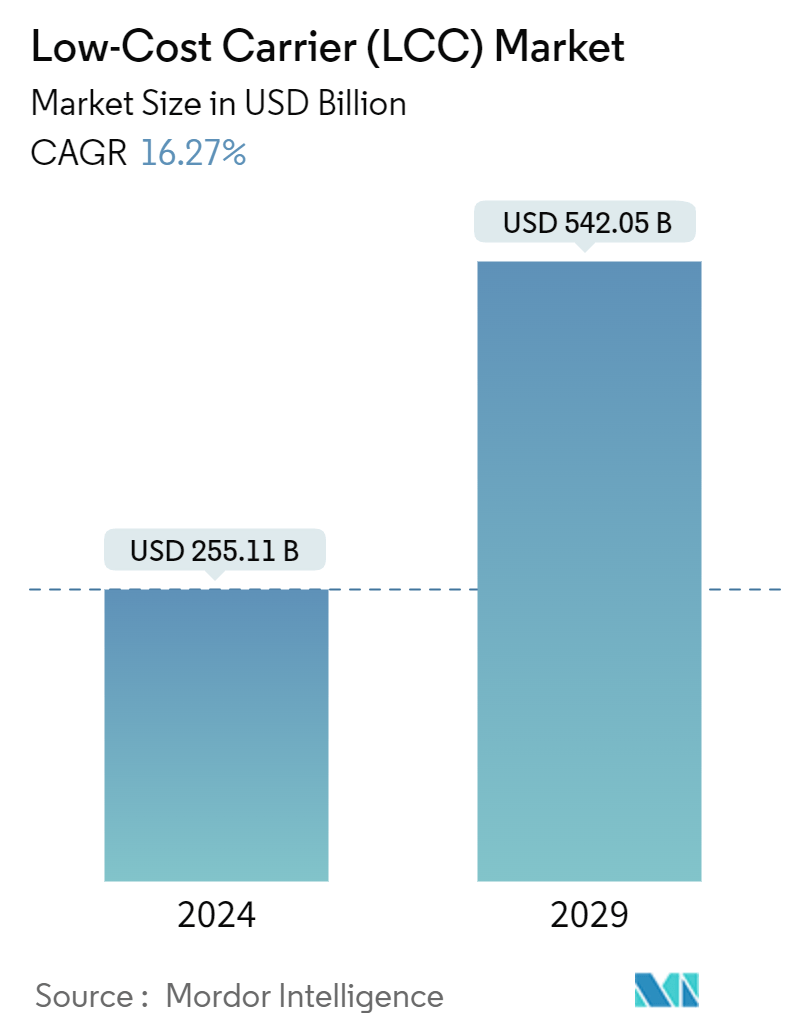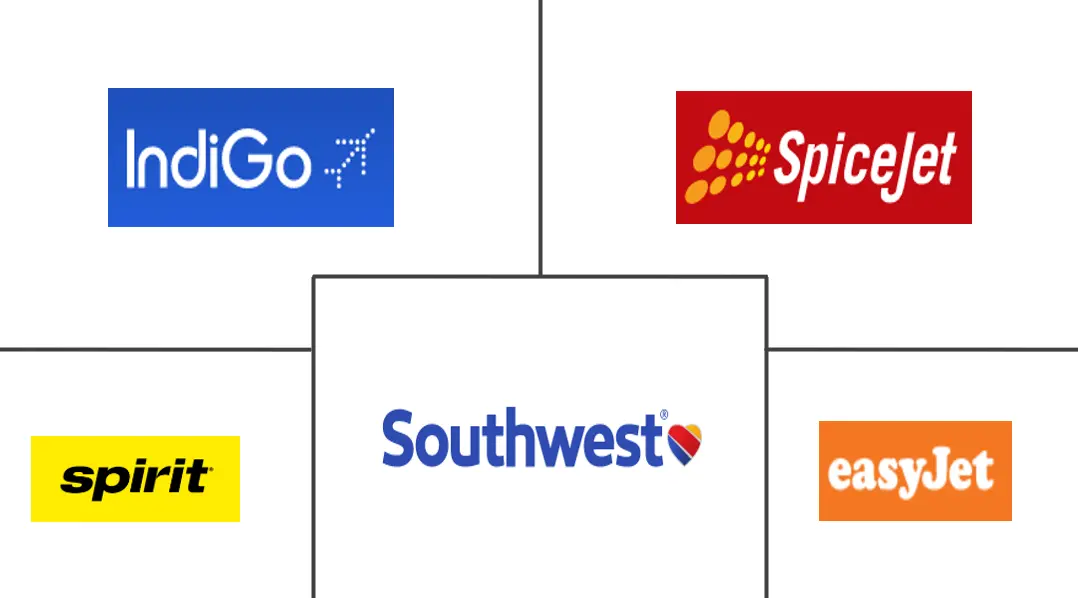Market Size of Low-Cost Carrier (LCC) Industry

| Study Period | 2019 - 2029 |
| Market Size (2024) | USD 255.11 Billion |
| Market Size (2029) | USD 542.05 Billion |
| CAGR (2024 - 2029) | 16.27 % |
| Fastest Growing Market | Asia-Pacific |
| Largest Market | North America |
| Market Concentration | Medium |
Major Players
*Disclaimer: Major Players sorted in no particular order |
Low-Cost Carrier (LCC) Market Analysis
The Low-Cost Carrier Market size is estimated at USD 255.11 billion in 2024, and is expected to reach USD 542.05 billion by 2029, growing at a CAGR of 16.27% during the forecast period (2024-2029).
Post-COVID-19, low-cost carriers (LCCs) spearheaded the airline sector's rebound. Their agility and cost-efficiency allowed them to swiftly cater to the surge in demand following the relaxation of travel restrictions. With the growing number of travelers prioritizing affordability over luxury, LCCs are poised for significant growth in the coming years.
Global low-cost airlines witnessed a remarkable surge in recent years, propelled by heightened economic activities, streamlined travel, a booming tourism sector, rapid urbanization, evolving lifestyles, and a clear consumer preference for budget-friendly, direct, and frequent services. Airlines are intensifying efforts to enhance aircraft sustainability in response to escalating sustainability concerns. This includes curbing carbon emissions, adopting sustainable aviation fuels, and exploring carbon capture technologies.
Budget airlines are strategically positioning themselves to capitalize on evolving travel trends and tap into previously overlooked markets by focusing on point-to-point air routes and extending services to underserved or secondary airports.
Low-Cost Carrier (LCC) Industry Segmentation
In contrast to traditional airlines, low-cost carriers prioritize lower fares over added comforts. By forgoing some standard services, they maintain a leaner operational cost structure. While ticket prices are notably reduced, these carriers offset the difference by charging for additional services like food, priority boarding, and baggage.
The low-cost carrier (LCC) market is segmented by aircraft type, destination, distribution channel, and geography. By aircraft type, the market is segmented into narrowbody and widebody aircraft. By destination, it is divided into domestic and international. By distribution channel, it is classified into online and travel agencies. The report also covers the market sizes and forecasts for the LCC market in major countries across different regions. For each segment, the market size is provided in terms of value (USD).
| Aircraft Type | |
| Narrow Body | |
| Wide Body Aircraft |
| Destination | |
| Domestic | |
| International |
| Distribution Channel | |
| Online | |
| Travel Agency |
| Geography | |||||||
| |||||||
| |||||||
| |||||||
| |||||||
|
Low-Cost Carrier (LCC) Market Size Summary
The low-cost carrier (LCC) market is experiencing robust growth, driven by the sector's resilience and adaptability in the post-COVID-19 landscape. LCCs have played a crucial role in the airline industry's recovery, leveraging their cost-effective operations to meet the increasing demand for affordable travel options. As more travelers prioritize budget-friendly choices over luxury, LCCs are well-positioned for substantial expansion. The market is characterized by a strategic focus on enhancing sustainability, with airlines adopting measures such as reducing carbon emissions and utilizing sustainable aviation fuels. This commitment to sustainability, coupled with the adoption of advanced narrowbody aircraft like the Airbus A321 and Boeing B737, underscores the sector's dedication to efficiency and environmental responsibility.
The Asia-Pacific region is expected to be a significant growth driver for the LCC market, fueled by economic development, policy changes, and rising incomes that have expanded air travel accessibility. The region's low-cost carriers have benefited from initiatives like the ASEAN Open Sky agreements, which have facilitated remarkable growth by offering affordable fares to a broader audience. Key players in the market, including Southwest Airlines, SpiceJet, and EasyJet, are expanding their reach through strategic partnerships and fleet enhancements to meet the growing demand. The market's competitive landscape is moderately fragmented, with both domestic and international players vying for market share. Collaborative efforts and technological advancements, such as those seen with Malaysia's MYAirline and Honeywell, are set to further propel the growth of the LCC market in the coming years.
Low-Cost Carrier (LCC) Market Size - Table of Contents
-
1. MARKET DYNAMICS
-
1.1 Market Overview
-
1.2 Market Drivers
-
1.3 Market Restraints
-
1.4 Industry Attractiveness - Porter's Five Forces Analysis
-
1.4.1 Threat of New Entrants
-
1.4.2 Bargaining Power of Buyers/Consumers
-
1.4.3 Bargaining Power of Suppliers
-
1.4.4 Threat of Substitute Products
-
1.4.5 Intensity of Competitive Rivalry
-
-
-
2. MARKET SEGMENTATION
-
2.1 Aircraft Type
-
2.1.1 Narrow Body
-
2.1.2 Wide Body Aircraft
-
-
2.2 Destination
-
2.2.1 Domestic
-
2.2.2 International
-
-
2.3 Distribution Channel
-
2.3.1 Online
-
2.3.2 Travel Agency
-
-
2.4 Geography
-
2.4.1 North America
-
2.4.1.1 United States
-
2.4.1.2 Canada
-
-
2.4.2 Europe
-
2.4.2.1 Germany
-
2.4.2.2 United Kingdom
-
2.4.2.3 France
-
2.4.2.4 Russia
-
2.4.2.5 Rest of Europe
-
-
2.4.3 Asia-Pacific
-
2.4.3.1 China
-
2.4.3.2 Japan
-
2.4.3.3 India
-
2.4.3.4 South Korea
-
2.4.3.5 Rest of Asia-Pacific
-
-
2.4.4 Latin America
-
2.4.4.1 Brazil
-
2.4.4.2 Rest of Latin America
-
-
2.4.5 Middle East and Africa
-
2.4.5.1 Saudi Arabia
-
2.4.5.2 United Arab Emirates
-
2.4.5.3 Rest of Middle East and Africa
-
-
-
Low-Cost Carrier (LCC) Market Size FAQs
How big is the Low-Cost Carrier Market?
The Low-Cost Carrier Market size is expected to reach USD 255.11 billion in 2024 and grow at a CAGR of 16.27% to reach USD 542.05 billion by 2029.
What is the current Low-Cost Carrier Market size?
In 2024, the Low-Cost Carrier Market size is expected to reach USD 255.11 billion.

